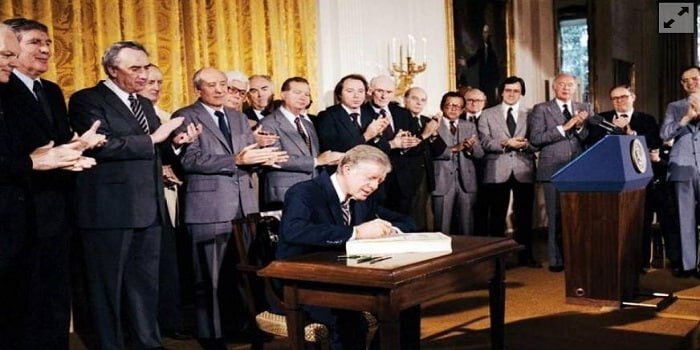46 years of economic warfare
A look at how US sanctions regime against Iran started, went on, and still persists today

TEHRAN – Economic sanctions are punitive measures imposed by one or more countries to pressure a targeted nation into changing its policies. Typically involving trade bans, asset freezes, and financial restrictions, sanctions are framed as a "peaceful" alternative to war. Yet in reality, they inflict severe suffering on ordinary people while often failing to achieve their political goals.
By restricting access to food, medicine, and essential goods, sanctions cripple economies, deepen poverty, and cause preventable deaths. Sanctions are frequently used not for genuine security concerns but as tools of economic warfare to destabilize nations that resist foreign dominance.
The United States first imposed economic sanctions on Iran following the Islamic Revolution and the takeover of the U.S. Embassy by Iranian revolutionary students.
Over the past 46 years, since the 1979 Revolution, Washington has repeatedly expanded its sanctions against Iran under various pretexts. These hostile measures have been justified by a shifting set of accusations, ranging from human rights violations and missile proliferation to allegations of terrorism and, most recently, Iran's nuclear program.
Carter takes the lead in imposing anti-Iran sanctions
Former U.S. President Jimmy Carter launched what would become a long-standing policy of sanctions against the newly formed Islamic Republic of Iran, citing the takeover of the U.S. Embassy in Tehran by revolutionary students on November 4, 1979. Initially, his administration tried to rally international support against Iran but soon found itself acting alone. Over time, however, some Western nations joined Washington in imposing sanctions.
On November 14, 1979, Carter signed Executive Order 12170, marking the start of sweeping economic pressure against Iran. By late December, the U.S. pushed for multilateral sanctions at the U.N. Security Council, but the Soviet Union blocked the move. Undeterred, Washington pressed ahead with unilateral sanctions while urging allies to follow suit.
The sanctions initially targeted military and oil trade but quickly escalated to the freezing of Iranian assets. The U.S. seized billions of dollars belonging to Iran, including bank deposits, gold, and other holdings. Executive Order 12170 alone locked up roughly $8.1 billion in Iranian funds and imposed a full trade embargo. On November 12, 1979, the U.S. halted oil imports from Iran, and two days later, the Office of Foreign Assets Control (OFAC) froze approximately $8 billion in Iranian assets.
The embassy takeover placed Carter under tremendous political strain. In a desperate move, he approved Operation Eagle Claw on April 25, 1980—a failed military mission to retrieve the captives. The operation ended in disaster when a sandstorm in Iran’s Tabas Desert grounded U.S. forces, leaving eight commandos dead. As the standoff dragged on, Carter cut diplomatic ties with Iran on April 7, 1980.
The Iranian students holding the embassy demanded the extradition of the ousted Shah, Mohammad Reza Pahlavi, whose regime had fallen in the February 11, 1979, revolution. They pointed out that the embassy workers had been carrying out espionage, branding the embassy a "Den of Spies." The captives remained in custody for 444 days, something that severely damaged Carter’s presidency. Alongside economic troubles—particularly soaring inflation—the saga with Iran contributed to his defeat in the 1980 election.
The captives were finally released on January 20, 1981, the very day Ronald Reagan was sworn into office. While the initial sanctions were lifted as part of the Algiers Accords, U.S. pressure on Iran never truly ceased, setting the stage for decades of continued tensions and Washington’s pursuit of economic terrorism.
Carter’s successors continue Iran sanctions under new pretexts
The sanctions initiated by Carter were only the beginning. Over the years, his successors issued eight additional executive orders against Iran, repeatedly renewing a state of national emergency concerning the country. Each administration expanded the scope of sanctions, blacklisting more Iranian entities and individuals. These measures were intended to force Iran into compliance with U.S. demands, yet over time, Iran adapted to the pressure, rendering the sanctions less effective.
Initially, U.S. sanctions targeted trade and financial transactions, but they gradually broadened to include restrictions on medicine, food, technology, and scientific development—measures that harm ordinary Iranians more than the government. However, Iran’s resilience and ability to circumvent sanctions through domestic production and alternative trade networks diminished their impact, frustrating Washington’s objectives.
Nowadays, the U.S. administration announces sanctions on Iranian-related entities and individuals almost every week, even though it has engaged in indirect talks with Iran through Oman's mediation. The indirect talks have focused on terminating sanctions on the part of the U.S. and accepting curbs on nuclear activities on the part of Iran.
